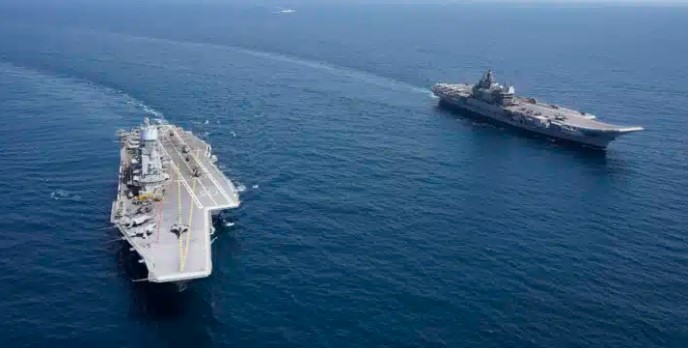Indian Navy press release
This demonstration of naval prowess underscores India’s commitment to safeguarding its national interests, maintaining regional stability, and fostering cooperative partnerships in the maritime domain.
It also marks a significant milestone in Indian Navy’s pursuit of enhancing maritime security and power-projection in the Indian Ocean, and beyond. The exercise involved seamless integration of two Aircraft Carriers INS Vikramaditya and the indigenously built INS Vikrant- along with a diverse fleet of ships, submarines and aircraft, showcasing India’s technological expertise in the maritime domain.
INS Vikramaditya and INS Vikrant, centre-pieces of the exercise, serve as ‘floating sovereign airfields’, providing a launch platform for a wide array of aircraft, including MiG-29K fighter jets, MH60R, Kamov, Sea King, Chetak and ALH helicopters. These mobile bases can be positioned anywhere, allowing for increased mission flexibility, timely response to emerging threats and sustained air operations to safeguard our national interests across the globe. In addition, they provide our friends with an assurance that the Indian Navy is capable and ready to support our ‘collective’ security needs in the Region.
The successful demonstration of two-carrier battle group operations serves as a powerful testament to the pivotal role of sea-based air power in maintaining maritime superiority. As India continues to strengthen its security apparatus, significance of Aircraft Carriers will remain paramount in shaping the nation’s defence strategy and promoting regional stability.
– End –
About INS Vikrant

Vikrant meaning victorious and gallant, the foundation for prestigious IAC was firmly established in April 2005 by ceremonial Steel Cutting. In order to push the indigenization drive, the Warship grade steel required for the construction of IAC was successfully indigenized through the Steel Authority of India Limited (SAIL) in collaboration with the Defence Research and Development Laboratory (DRDL) and the Indian Navy. The hull fabrication progressed thereafter and the ship’s keel was laid in February 2009. The first phase of ship construction was completed with the successful launch of the ship in August 2013.
The readiness of the ship’s propulsion and Power generation equipment/ systems in the harbor was tested as part of Basin Trials on Nov 20. Vikrant has completed multiple phases of Sea Trials from August 2021 to date, where the ship’s performance, including the response of the ship’s hull to various conditions of operations, maneuvering trials, main propulsion, Power Generation, and Distribution (PGD), ship’s Navigation and Communication systems, endurance testing of propulsion machinery, and so on.
The 262 m long and 62 m wide Vikrant displaces approx 43000 T when fully loaded, having a maximum designed speed of 28 Knots with an endurance of 7500 NM. The ship has around 2200 compartments, designed for a crew of around 1600 that include specialized cabins to accommodate women officers and sailors. The carrier is designed with a very high degree of automation for machinery operations, ship navigation, and survivability.
The ship would be capable of operating an air wing consisting of 30 aircraft comprising of MiG-29K fighter jets, Kamov-31, MH-60R multi-role helicopters, in addition to indigenously manufactured Advanced Light Helicopters (ALH) and Light Combat Aircraft (LCA) (Navy). Using a novel aircraft-operation mode known as Short Take-Off But Arrested Recovery (STOBAR), the IAC is equipped with a ski-jump for launching aircraft, and a set of three ‘arrester wires’ for their recovery onboard.
The ship boasts of a fully-fledged Medical Complex with the latest medical equipment facilities that include major modular OT, emergency modular OT, physiotherapy clinic, ICU, laboratories, CT scanner, X-Ray machines, Dental complex, Isolation ward, telemedicine facilities, etc.
Specifications of Vikrant:
- Length: 262.5 m
- Width: 61.6 m
- Height (Keel to pole mast): 61.6 m
- Displacement: appx 42.800 tonnes
- Speed (Max/Cruise): 28/18 knots
- Flight Deck area: 12.500 SqM
- Propulsion: GTs – 22MWx4, DAs – 3MWx8
- Range: 7500 Nautical Miles
- Weapons: SAM – 32xMRSAM, AK630 CIWS
- Air Wing: Mix of 30 Aircraft & Helicopters
- Runway: Landing – 191m, Long Take-off – 203m, Short Take-off – 145m
- Helo landing spots: 6
- 3 x Arresting Gear Wires
- 2 x SAC lifts (10×14 m)





